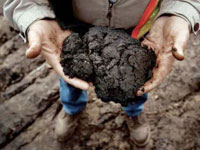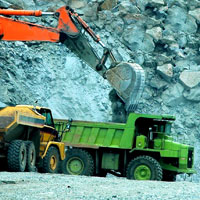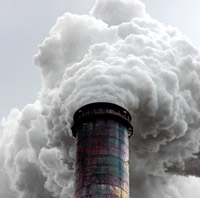
News |
- Canada Ready For Clean Energy
- Dilbit Still Killing Kalamazoo River
- Arctic Methane Release Dubbed a Time Bomb
- Germany Sets Another Solar Power Record
- Cold Lake Alberta Tar Sands Blowout Defies Understanding
- Oilsands Expansion Despite Environmental Impacts
- Ontario Moves To Protect Bees
- Half Of Whiteshell Park Not Protected
- GHG Emissions Information Gap
- New Lawsuit Against Monsanto
- Manitoba Lawn Pesticide Ban Starts 2015
- 21,000 Species Face Extinction
| Canada Ready For Clean Energy | 26 July 13 |

A recent poll conducted by Harris-Decima found that Canadians clearly understand the imperative and opportunity of a low-carbon transition, and the role an integrated climate and energy strategy can play. When asked whether "We need a Canadian climate and energy strategy to plan our nation's energy future," a remarkable 87 per cent of Canadians agree. With 62 per cent agreeing that, "A Canadian energy strategy will only be successful if it transitions Canada to a low-carbon economy." Canada will have enough renewable energy by 2050 to achieve the deep greenhouse gas (GHG) reductions required to put a brake on global climate change, according to a report released by the Trottier Energy Futures Project (TEFP). An Inventory of Low-Carbon Energy for Canada shows that Canada's supplies of solar, wind, hydroelectric and biomass energy are much larger than the current or forecast demand for fuel and electricity. Technology costs have also been falling in recent years. The report is a joint project of the Suzuki and Trottier Foundations. View July 23, 2013 The Globe and Mail articleView July 23, 2013 Clean Energy Canada article View June 26, 2013 Yahoo! News article View March 27, 2013 David Suzuki Foundation article View Trottier Energy Futures Project website |
|
 Print version Print version |
Top |
| Dilbit Still Killing Kalamazoo River | 26 July 13 |

Source: pipe-up.net
An aging oil pipeline burst on July 25, 2010 and spilled more than one million gallons of heavy Canadian tar sands bitumen oil into the Kalamazoo River. It was the largest inland oil pipeline spill in U.S. history. The Kalamazoo accident was the first major pipeline spill involving diluted bitumen, or dilbit, the same type of oil that will be carried by the Keystone XL pipeline if the Obama administration approves the project. "You can look at the river and say it looks good but there are so many things that fly under the radar–those are the things that we will be monitoring for years," said Michelle DeLong, who is leading the Michigan Department of Environmental Quality (MDEQ). View July 25, 2013 Inside Climate News articleView United States Environmental Protection Agency Oil Cleanup Continues On Kalamazoo River page View Department of Environmental Quality Oil Spill News and Updates page View June 26, 2012 Inside climate News article |
|
 Print version Print version |
Top |
| Arctic Methane Release Dubbed a Time Bomb | 26 July 13 |

A recent article in Nature assumes that the "costs of a melting Artic will be huge, because the region is pivotal to the function of earth's systems, such as oceans and the climate." Scientists and economists said that the release of the methane, trapped for thousands of years beneath the frozen permafrost of the Arctic, is one of the most dangerous "feedback" consequences of the rapid warming of the region, a process which has seen sea ice diminish by more than a third since the 1970s. "We are looking at a big effect, possibly a catastrophic effect on global climate that has been a consequence of the extremely fast sea-ice retreat we've seen in recent years," Professor Wadhams said, of Cambridge University, who was part of the study team. "We have an area of the world that used to be covered with sea ice all the year round but which is now, in the summer months, becoming ice free," he added. View July 26, 2013 Independent Online articleView July 25, 2013 Macmillan Publishers Limited article View July 25, 2013 The Guardian article View July 24, 2013 Common Dreams article |
|
 Print version Print version |
Top |
| Germany Sets Another Solar Power Record | 26 July 13 |

After the Fukushima Daiichi nuclear plant disaster in Japan, Germany adopted a policy of phasing out nuclear energy by 2022 and ensuring that 80 percent of the country's electricity supply comes from clean energy by 2050. Even with starting to phase out its nuclear power plants, Germany has seen its power output quadruple since 2011. View July 22, 2013 E&E Publishing articleView July 18, 2013 Forbes article View July 8, 2013 Inhabitat article View July 5, 2013 Deutsche Welle article View June 28, 2013 Bloomberg article View Performance of Photovoltaics (PV) in Germany |
|
 Print version Print version |
Top |
| Cold Lake Alberta Tar Sands Blowout Defies Understanding | 19 July 13 |

The well and blowout have cast doubts on the safety of underground extraction methods, according to documents obtained by the Toronto Star and a government scientist who has been on site. The scientist says there are four separate sites involved, all of which are on the Cold Lake Air Weapons Range. Over 30,000 kg of oil vegetation has been cleared from the most recent of the four sites. These Cold Lake Natural Resources Ltd operations are on the traditional territory of the Beaver Lake Cree First Nation which is pursuing a constitutional challenge that argues the cumulative impacts of oil sands industrial development are infringing their treaty rights to hunt, fish and trap. "This is a new kind of oil spill and there is no 'off button,' " said Keith Stewart, an energy analyst with Greenpeace who teaches a course on energy policy and environment at the University of Toronto. "You can't cap it like a conventional oil well or turn off a valve on a pipeline." View July 19, 2013 Toronto Star articleView June 27, 2013 CBC News article View May 28, 2013 Huffington Post article View DeSmog Canada: Cold Lake Air Weapons Range View July 23, 2013 Daily Kos article |
|
 Print version Print version |
Top |
| Oilsands Expansion Despite Environmental Impacts | 19 July 13 |

Environmental groups were disappointed. Simon Dyer, policy director at the Pembina Institute, an environmental think tank, said Canada's reputation is being put further at risk as it keeps approving oil-sands projects in the absence of adequate rules for global warming or wetland protection. "We are disappointed to see that the review panel is recommending approval of the Shell Jackpine mine expansion project, despite noting that the project lacks adequate mitigation and will contribute (along with other planned projects) to very significant adverse impacts to aboriginal rights and values, wildlife populations, wetlands, migratory birds and old-growth forests," Mr. Dyer said. "The joint review panel heard Shell's own analysis that this project, when added to other planned oilsands projects, will exceed science-based environmental limits for impacts to air quality, wildlife habitat and the Athabasca River — yet the panel recommended approval of the project anyway." View July 9, 2013 The Globe and Mail articleView July 9, 2013 Pembina Institute media release View June 20, 2013 Pembina Institute report View June 12, 2013 The Globe and Mail article View October 22, 2012 Pembina Institute report |
|
 Print version Print version |
Top |
| Ontario Moves To Protect Bees | 19 July 13 |

Source: bees.chrisinch.com
There are about 80,000 bee hives in Ontario, operated by some 250 professional beekeepers and another 4,000 hobby beekeepers. In 2012, over 6 per cent of bee colony populations were lost, and beekeepers and environmentalists are now calling for a ban on neonicotinoids, much like the one just introduced in Europe. The Ontario Beekeepers' Association, Sierra Club Canada and the Green Party are pushing for a federal ban. "It's like a game of roulette now ...nothing stops the bees from being in contact with the pesticides," says association spokesperson Tibor Szabo. Corn farmers will have a different view. A bee health working group is being formed by the Ontario gorvernment to make recommendations on how to mitigate the potential risk of a certain pesticide to honey bees. The group will comprise beekeepers, farmers, people in agri-business and scientists as well as staff from federal and provincial agencies View July 9, 2013 Maclean's articleView July 9, 2013 Huffington Post article View July 5, 2013 Toronto Star article View May 31, 2013 Ontario Beekeepers Association article View May 13, 2013 Toronto Star editorial View May 6, 2013 Toronto Star article View April 2, 2013 Alliance for Natural Health article |
|
 Print version Print version |
Top |
| Half Of Whiteshell Park Not Protected | 19 July 13 |

"Easily the biggest improvement in Whiteshell Provincial Park history was the ban on industrial logging that finally occurred in 2009," said Eric Reder, Campaign Director for the Wilderness Committee. "Nearly half of Whiteshell--47%--is still open for mining and mineral exploration activity and other development. Manitoba provincial parks need to be "improved" so that they are protected areas, like parks across Canada." Manitobans, when asked, have overwhelmingly supported more park protection, but the Manitoba government needs to be dragged towards proper protection for Whiteshell Park. From 2009, Manitobans have been waiting to see some of the area around Meditation Lake protected. In fact, protection for these lands and waters in Whiteshell Park has been the subject of at least three government news releases--the latest in March of this year--but it still hasn't happened. View July 19, 2013 Manitoba Wilderness Committee articleView July 19, 2013 CBC News article View July 19, 2013 CTV News article View Whiteshell Provincial Park website |
|
 Print version Print version |
Top |
| GHG Emissions Information Gap | 5 July 13 |

Environment Canada, which references some Statistics Canada data in its annual greenhouse gas (GHG) emissions inventories stated it still needed to review “ available information and assess its potential use”. The annual GHG report by Environment Canada is mandatory and required under the Canadian government’s international climate change commitments Data released this spring by Environment Canada indicate Manitoba's greenhouse gas emissions were at 19,500 kilotonnes in 2011, down by one per cent over 2010. Current reductions are nowhere near the promise to shrink emissions in Manitoba to levels mandated by the Kyoto Protocol. Manitoba’s emissions in 1990 were18,300 kilotonnes of CO2 equivalent emissions and in 2000 it was 21,000 kilotonnes. Manitoba Minister of Environment and Conservation, Gord Mackintosh said Manitoba's Kyoto promise was in part thwarted by federal inaction on climate change. View July 5, 2013 Aljazeera articleView July 4, 2013 The Canadian - Agora Cosmopolitan article View June 28, 2013 Canada.com article View June 21, 2013 Winnipeg Free Press article View Statistics Canada Survey Methods and Practices guide |
|
 Print version Print version |
Top |
| New Lawsuit Against Monsanto | 5 July 13 |

Monsanto has sued many farmers when their GM crops have turned up in the farmer's fields even though the farmers state they never planted them. Farmers who get into the Roundup-Ready (RR) System lose their independence, and are obliged to sign a lengthy and restrictive agreement. Monsanto often contracts private investigation firms like Pinkerton, to check up on farmers and independent, non-GM farmers, taking samples unannounced from their fields to make sure they are not in violation. Monsanto also maintains a hotline so farmers can turn in their neighbours for suspected violations. View June 26, 2013 Huffington Post articleView June 6, 2013 Reuters article View June 6, 2013 Huffington Post article View March 30, 2011 Mother Earth News article View May 2007 Archives of Environmental Contamination and Toxicology article |
|
 Print version Print version |
Top |
| Manitoba Lawn Pesticide Ban Starts 2015 | 5 July 13 |

Agricultural lands, golf courses and sod farms would be exempt from the ban. If the ban goes through, Manitobans would only be allowed to use bio-pesticides and organic methods to control weeds on their lawns. "Medical experts are clear that synthetic chemical lawn pesticides pose risks to human health, especially in the early stages of life, and to pets as well. We must reduce exposure to these products where they are not needed," said Mackintosh. "Given the increasing availability of replacement products and alternative turf management practices that effectively control weeds, Manitoba is proposing to join most other provinces and more than 170 Canadian municipalities to protect human, pet and environmental health." View June 28, 2013 CBC News articleView June 28, 2013 Manitoba Government news release View Cosmetic Pesticide Ban Manitoba blog View Government of Canada Pests And Pesticides page |
|
 Print version Print version |
Top |
| 21,000 Species Face Extinction | 5 July 13 |

The IUCN has now added 4,807 species in its latest "Red List", bringing the total number of threatened species to 70,294, of which 20,934 are on the edge of extinction. "Thanks to the IUCN Red List, we now have more information on the state of the world's biodiversity than ever before," says Jane Smart, Global Director, IUCN Biodiversity Conservation Group. "But the overall picture is alarming. We must use this knowledge to its fullest – making our conservation efforts well targeted and efficient - if we are serious about stopping the extinction crisis that continues to threaten all life on Earth." This update of The IUCN Red List provides results of the first-ever global assessment of freshwater shrimps, of which 28% are threatened with extinction. Ten percent are used for human consumption, including the Giant River Prawn (macrobrachium rosenbergii), and they are an important part of the freshwater food web. Pollution, modification of habitat and the aquarium trade are some of the primary threats. View July 2, 2013 IUCN articleView July 2, 2013 Nature World News article View The IUCN Red List of Endangered Species View July 3, 2013 NewsPoint article View July 2, 2013 Common Dreams article |
|
 Print version Print version |
Top |


 RSS Feeds:
RSS Feeds: